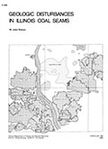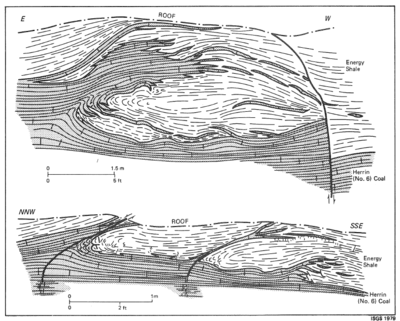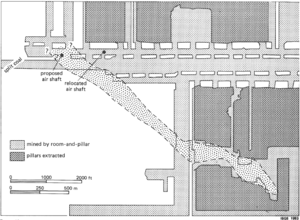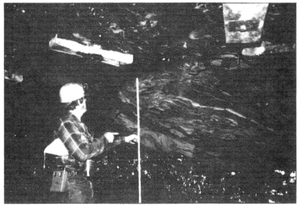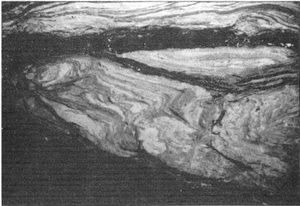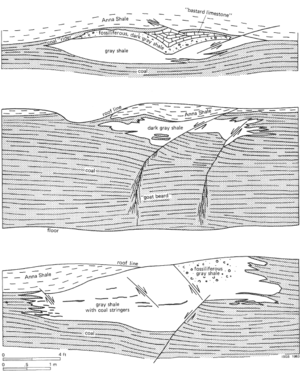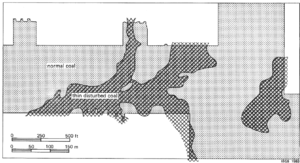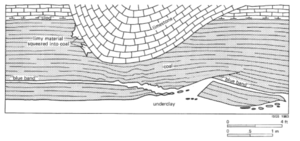Circular 530 Rolls
| Geologic Disturbances in Illinois Coal Seams | ||||||||||
|---|---|---|---|---|---|---|---|---|---|---|
| Channels | Split Coal | Rolls | Limestone Bosses | Clay Dikes | White Top | Igneous Dikes | Joints | Coal Balls | Miscellaneous Disturbances | Acknowledgments |
Rolls
Roll has no precise geologic definition. In different coal fields, it means different things. Rolls may simply be coal beds with hills and valleys that vary in thickness. In Illinois, these hills and valleys are not usually called rolls, although hilly coal is sometimes said to be rolly. In other parts of the world, rolls are long ridges or abrupt rises in the floor, inning the seam. This type of disturbance is rare in Illinois mines, where the term rolls means some kind of downward bulge in the roof or a large mass of rock near the top of the coal, producing a seam that thins and/or dips downward. In this report, rolls are
- long and narrow in map view and football-shaped in cross section;
- attached directly to the roof or separated by thin layers of coal;
- involved with some loss or displacement of coal from the top of the seam;
- not identified elsewhere in this report as channels or other features (although some rolls may also be small channels, since the categories are not mutually exclusive).
The following descriptions of rolls are based on rock type.
Rolls of Gray Shale and Siltstone
Rolls are numerous and widespread in coal seams overlain by gray shale, silty shale, and siltstone-originally crevasse-splays along major channels in the peat bogs. Particularly affected by rolls are the Springfield (No. 5) Coal, where it is overlain by Dykersburg Shale, and the Herrin (No. 6) Coal, where it is overlain by Energy Shale. Although the Murphysboro, Colchester, and Danville Coals also contain rolls of gray shale and siltstone, fewer details are available because these seams are not being mined currently. Rolls are rare or absent in seams overlain by well laminated, dark gray to black, fine-grained shales of marine origin.
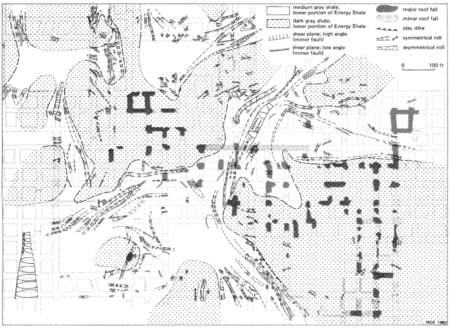
Typically, rolls are the same rock as the roof. Most gray shale and siltstone rolls are lens shaped in cross section (fig. 21). They range from a few feet to several tens of feet wide and from less than 1 foot to about 7 feet high. Generally the upper layers of coal split away from the main seam and overlap the rolls as riders. A few rolls with continuous riders across the top appear as shale lenses within the coal; but in most cases, the riders splay into the roof above the rolls. Several feet of coal may be missing from the top of the seam under rolls. The layers of coal below the rolls are bowed downward, and in large rolls, the floor may also be depressed. In map view, rolls are long and thin (fig. 22). Rolls several hundred feet long are common, although a few more than 1000 feet long have been mapped (Krausse et al., 1979). Most rolls are curved. Some are isolated; others form parallel sets or swarms.
The distribution of rolls often appears to be random, but detailed mapping may reveal patterns. For example, at the Orient Mine No. 6 in Jefferson County, two types of shale occur in the roof (Krausse et al., 1979; Edwards et al., 1979). Dark gray, carbonaceous, thinly laminated shale up to 7 feet thick discontinuously overlies the coal. Above the dark shale or directly on the coal where the dark shale is missing lies a light to medium gray silty shale with poorly defined bedding; the light shale is 40 feet thick or more. Both shales constitute the Energy Shale Member; however, rolls are found only where the light shale forms the immediate roof, running parallel to the boundary between light and dark shale (fig. 22).
Edwards et al. (1979) proposed that masses of light gray mud slid or slumped between the layers of still -soft peat, producing rolls. I believe a different explanation accounts for the observed structure and distribution of rolls at the Orient Mine No. 6: Accumulation of peat ended as the coal swamp gradually submerged and vegetation drowned. Dark layers of mud settled in the quiet waters of the flooded swamp and eventually buried the peat, more or less uniformly. Then a crevasse opened in the natural levee of the Walshville river, and water laden with light gray mud and silt from the river coursed through the swamp. The flow was not channelized, but sheetlike; it spread like a fan away from the crevasse. In places, strong currents washed away the previously deposited dark mud, and ripped up mats of the underlying peat. Sediments deposited in the resulting elongate scours became rolls. In time 40 feet or more of light gray mud and silt covered the entire peat deposit, before sea level rose and brought marine sediments into the region.
Many mines in the Herrin (No. 6) Coal have a roof of uniform, gray silty shale or siltstone, with rolls but no lenses of dark gray shale as at Orient No. 6. Rolls in such mines may have formed in the manner described above, except that the initial dark mud either was not deposited or was eroded entirely during the crevasse-splay phase. Few, if any, rolls I have observed in gray shale or siltstone of Illinois show evidence of origin by slumping or unequal loading of soft sediments. Such deformation should result in highly contorted or destroyed laminations in the shale or siltstone filling the rolls. To the contrary, most rolls show distinct layers conforming closely to the cross-sectional shape of the roll (fig. 21). The slight deformation near the margins of the roll can be attributed to either eddying water currents during deposition or to squeezing of sediments during burial and compaction.
Mining problems.
Maintaining uniform working height is difficult in underground mines where many rolls occur, since continuous miners have trouble following the contours of rolly coal. Miners must take large amounts of rock with the coal or leave coal in the roof; so productivity is lowered or reserves are lost. Also, rolls do not make stable roof. Small faults or slips occur along the edges of these structures, weakening the roof. Separation of large masses of rock is likely along slips and splayed coal riders accompanying most rolls. Extra costs are imposed by the additional bolting and timbering required in roily sections.
Rolls of Sandstone
Rolls are common in coal directly overlain by the sandstone found close to major channels such as the Walshville and Galatia. The largest rolls in Illinois are associated with sandstone roof; some are more than 100 feet wide, thousands of feet long, and affect the entire thickness of the seam.
A belt of large sandstone-filled rolls has been mapped in the inland Steel Mine No. 1 in Jefferson County, about 1 mile east of the Walshville channel (fig. 23). The belt is at least 7008 feet long, 200 to 600 feet wide, and trends southwesterly along a slightly curved path. It extends into the northwestern workings of Old Ben Mine No. 21, south of the Inland mine. The coal undulates strongly and thickness varies extremely throughout the zone of rolls. The coal tends to thicken on the rises and thin in the troughs. Along some of the larger rolls, more than half the normal thickness of the coal is missing. The upper layers of the seam splay irregularly into the sandstone rolls (fig. 24).
Along the belt of rolls, the same sandstone fills the rolls and forms the roof of the coal. It is light gray, generally fine-grained, micaceous sandstone with closely spaced partings of black carbonaceous shale. Locally it is cross-bedded and contains large stringers or mats of eroded coal. Along the margins of the belt of rolls, this sandstone overlies gray silty shale or siltstone with an angular contact. The shale or siltstone, which makes up the roof in most of the mine, contains rolls; but most are small and inconspicuous.
Clearly the sandstone rolls at the inland Mine No. 1 are erosional in origin. First, peat was covered by gray mud and silt, probably deposited as a crevasse splay from the Walshville channel. Later a stream (perhaps a distributary of the Walshville river) cut through the mud and silt, locally exposing and eroding peat. Sand settled in the streambed. The undulations in the coal probably resulted from uneven loading and compaction of the peat and sand. As sand is considerably denser than peat, it tends to weight unevenly and may displace still-soft peat. Also sand is less compressible than peat; so a lens-shaped body of sand tends to hold its shape during compaction, while the pliable peat conforms to the shape of the sand body.
Mining problems.
Mining through the belt of sandstone-filled rolls was difficult. The highly irregular contour and thickness of the coal were hard to follow. in places the coal dipped so steeply that the mining machine could not negotiate the grade; to maintain headway, it had to either cut through rock or backfill its opening. Along one set of entries the coal was almost completely eroded. headings were detoured, while others were driven through solid sandstone to ventilate the workings. Unstable roof conditions and a heavy influx of groundwater from the sandstone compounded the problems. The sandstone readily split into layers along the carbonaceous partings, often separating just above the anchoring point of the roof bolts.
Rolls of Gray Shale Under Black Shale
Large gray shale rolls occur commonly under black shale roof in the Herrin (No. 6) Coal of Franklin and Williamson Counties. Typical rolls have been studied at several mines, especially OId Ben Mine No. 24 near Benton. In this mine, most coal lies under Energy Shale-the usual light to medium gray shale developed as overbank or crevasse-splay deposits from the Walshville channel. Overlying the Energy Shale with a sharp, angular, clearly erosional contact is the black fissile Anna Shale, a marine deposit. Although the Energy Shale can be more than 25 feet thick, it is locally missing, apparently due to erosion; the Anna Shale forms the immediate roof in these places. Not only Energy Shale but some coal was eroded as welt. Measurements show truncated layers of coal directly beneath the Anna Shale (Bauer and DeMaris, 1982).
At Old Ben Mine No. 4, most rolls are found where black shale lies directly on the coal, although all rolls are filled with gray shale (fig. 25). The tops of the rolls are cleanly truncated at the base of the Anna Shale. Some are planed off at the top of the coal; but in most, the gray shale and overlying black shale arch gently. Clearly, the rolls formed before deposition of the Anna Shale.
These rolls also show evidence of erosional origin. The uppermost layers of coal are missing, replaced by gray shale. The splayed ends of coal layers interfinger with shale along the edges of the rolls; and the upper coal layers partly, or in rare cases, completely overlap the shale. Slips may offset the lower layers of coal, but the floor is not depressed.
Large masses of shaly, fossiliferous dark gray limestone also occur along the crests of some roils. A few small rolls are filled entirely with dark gray, fossiliferous shale. Rolls at Old Ben Mine No. 24 are among the longest documented in Illinois: most are hundreds of feet long and several exceed 1000 feet. Occurring in parallel sets or swarms, they follow the linear belts where Anna Shale forms the immediate roof (fig. 26). Some lie entirely under Anna Shale, while others follow the boundary between Energy and Anna Shales.

One might surmise that these rolls, like the ones at the Orient Mine No. 6, were scoured during the initial stages of Energy Shale deposition when crevasse splays invaded the peat swamp. Such an explanation is unlikely, however, as it fails to account for the observed distribution of rolls. Why are there almost no rolls in the areas still overlain by thick Energy Shale?
Bauer and DeMaris (1982) theorize that the rolls developed after the Energy hale sediments blanketed the entire area of the mine. Strong currents, possibly from the Walshville channel, eroded broad sinuous pathways to the peat through the Energy Shale deposits. In some places, peat was also removed, either uniformly and layer-by-layer, or along deep, narrow, parallel troughs. Subsequently, rolls formed as the troughs filled with reworked Energy Shale, or Iocally, with tidal deposits of fossiliferous shale and limestone. Immediately after these events, the sea came in and covered peat, rolls, and Energy Shale sediments with black mud that became the Anna Shale.
One final point: rarely are rolls filled entirely with black shale. Krausse et al. (1979b) observed several small roll-like intrusions of black shale, which they termed washouts, at a mine in the Herrin Coal in west-central Illinois. Whether these structures actually are due to erosion is not certain. Since they are small and local, they have no influence on mining.
Mining problems.
Rolls at Old Ben Mine No. 24 are a moderate hindrance. They reduce the height of the coal seam, so it may be difficult to avoid mining some rock. The roof is hard to support along rolls because the gray shale is soft and usually contains numerous slip-factures. Also, the gray shale is much weaker than the Anna Shale, which normally remains stable for many years.
Rolls of Limestone
Two distinct types of limestone rolls have been observed in coal seams overlain by limestone in the Illinois Basin. One type is broad, low, and irregular in map view; and the other is narrow, deep, and linear.
The broad, low type of roll has been encountered in the Herrin (No. 6) Coal at the Peabody River King Underground Mine in St. Clair County (fig. 27). Under rolls, the coal loses half its normal thickness, and in places is reduced to less than 2 feet. Also, the upper layers of coal are truncated beneath the limestone. Coal remaining beneath the roll is duller and harder than normal, and shows disrupted banding. In some places, this dull, disturbed coal is partially replaced by large nodules of extremely hard black silica. Unlike rolls discussed previously, these rolls have irregular branching or lobate outlines rather than linear or sinuous paths; their boundaries are not clearly defined (fig. 28). Their width varies greatly, and their distribution has not been determined.
The rolls at the River King Mine probably reflect erosion and partial oxidation or degradation of the peat before coalification. River King lies close to the Ozark region, at the southwestern margin of the Illinois Basin. Portions of the Ozarks may have stood as uplands, above the level of the coastal swamps where Herrin peat was accumulating. Well oxygenated water from Ozark streams may have flowed into the marginal swamps, removing some peat and causing additional peat to oxidize. These same waters could haw been rich in silica leached from the granitic, upland rocks. Upon entering the acidic waters of the peat swamp, the silica precipitated, replacing some peat.
The narrow, linear type of limestone roll interferes with mining at Peabody Camp Mine No. 11 in Union County, Kentucky (about "1 miles from the Illinois border). The Herrin Coal in this mine is directly overlain by massive limestone. The rolls, called horsebacks by miners, are many hundreds of feet long and all run parallel toward the northwest. They range from a few feet to about 20 feet across. Under the larger ones, the coal almost pinches out entirely and underclay must be removed to cross them. The coal appears to have been squeezed from under the rolls, and many large slips are present (fig. 29). These rolls may have formed when limy sediments slumped downward into the peat before coalification.
References
- Edwards, M. J., R. L. Langenheim, Jr., W. J. Nelson, and C. T. Ledvina, 1979, Lithologic patterns in the Energy Shale Member and the origin of "rolls" in the Herrin (No. 6) Coal Member, Pennsylvanian, in the Orient No. 6 Mine, Jefferson County, Illinois: Journal of Sedimentary Petrology, v. 49, no. 2, 1979.
- DeMaris, P. J., R. A. Bauer, R. A. Cahill, and H. H. Damberger, 1983, Geologic investigation of roof and floor strata: longwall demonstration, Old Ben Mine No. 24. Prediction of coal balls in the Herrin Coal: lllinois State Geological Survey Contract/ Grant Report 1983-2,69 p.
- Krausse, H.-F., H. H. Damberger, W. J. Nelson, S. R. Hunt, C. T. Ledvina, C. G. Treworgy, and W. A. White, 1979a, Roof strata of the Herrin (No. 6) Coal and associated rock in Illinois-a summary report: lllinois State Geological Survey Mineral Notes 72, 54 p.
- Krausse, H.-F., H. H. Damberger, W. J. Nelson, S. R. Hunt, C. T. Ledvina, C. G. Treworgy, and W. A. White, 1979b, Engineering study of structural geologic features of the Herrin (No. 6) Coal and associated rock in Illinois. Volume 2: lllinois State Geological Survey, Final Contract Report to U.S. Bureau of Mines H0242017, 205 p.

